Chèvre Recipe
If I thought I became upset upon learning how easy it is to make queso blanco, I cannot describe what I felt the first time I made chèvre. When I say it is easy, I mean that it takes practically no effort whatsoever. When I go to the store now, I shake my head woefully at the tubs of overpriced chèvre hanging out on the shelves. How could cheesemakers charge so much for it? I just don’t know.
Chèvre comes from the French word for goat, and it is therefore a goat’s milk cheese. Depending on the bacterial culture you use and the manner in which it is drained, it can range from very creamy and mild to sharp and crumbly. I prefer to use a starter that has only two strains of bacteria: Lactococcus lactis sp. lactis and Lactococcus lactis sp. cremoris. These produce enough acid to coagulate the curds, but they don’t produce CO2 or diacetyls which give off a buttery flavor. I think this really lets the character of the milk shine through, and it makes for a good cheese to give to people who maybe aren’t that in to goat cheese.
My favorite way to enjoy chèvre is to put a generous smear on a slice of fresh baguette, slice up a dried fig and put half of it on the cheese, and then add a small dollop of toasted walnuts in honey on top.
I dream about this. So delicious! Consider it a gateway drug…
When I first started making this cheese, I would bring my milk up to 70°F in a pot on the stove. However, when I thought about it a little more, it gets left at room temperature for 24 hours to ripen – so that initial heat really doesn’t make that much of a difference. I tend to leave the milk out on the counter after I bring it home from the store, and then pour it in to a pot.
When the milk is warm enough to not cause condensation on the side of the pot, I add my starter culture. I sprinkle 1/16th of a teaspoon of my culture evenly over the surface of the milk and let it hang out for a few minutes to wake up. At that point, I give it a good stir.
Although this cheese is predominately coagulated by the lactic acid produced by our little bacteria friends, we do add some rennet. I use these handy little measuring cups in order to get a good measure:
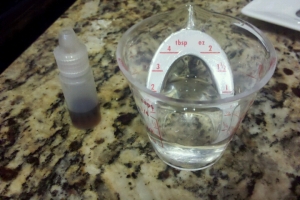
I add one drop of liquid rennet to 4 tablespoons of bottled water. Then I slowly trickle 2 tablespoons of this mixture in to the pot and stir for about 20 seconds. Put the lid on the pot and leave it alone at room temperature for 24 hours. Yes, that’s it. Easy!
After 24 hours, when you open the pot you should see a clear separation between the curds and the whey.
Boil your butter muslin for 5 minutes and set up the draining station in the sink or over a clean bowl. Carefully ladle the curds in to the muslin-lined colander.
You don’t want to pour your curds in to the colander because they are quite fragile. This will help maintain a creamy consistency in your cheese. Once all the curds are out of the pot, let them sit in the colander for a few minutes to drain.
Tie your curds up in to a bag and let them drain for 12 hours at room temperature. The cheese will ripen further at this point, so don’t skimp on the draining time!
I drain my curds over a glass so that I can retain the whey. I love to use goat whey to make bread – a recipe I shall share sometime in the murky future. It’s delicious!
After the draining time is over, unwrap the cheese and place it in a clean container. I have a scale that weighs by grams, so I add 1 gram of kosher salt per 100 grams of cheese. If you don’t have a scale, you can add salt to taste. It’s probably better that way.
When it’s done, it should keep for a week or so. However, I find it doesn’t stay in my fridge for long.
Chèvre
1/2 gallon of goat milk
1/16th tsp Mesophilic Culture 1
1 drop rennet (double strength)
4 tbsp bottled water
- Pour the milk in to a pot and bring to 70°F or room temperature.
- Sprinkle the culture over the surface of the milk. Let bloom for 2 minutes.
- Add one drop of rennet to the 4 tbsp water. Carefully trickle 2 tbsp of the mixture in to the milk. Mix gently for 20 seconds.
- Put a lid on the pot and let ripen for 24 hours at room temperature.
- Boil butter muslin for 5 minutes. Line a colander with the muslin.
- Carefully ladle the curds in to the colander. Let drain for 5 minutes.
- Tie up the muslin and hang over a container for 12 hours at room temperature.
- Empty the curds out in to a container and add salt (1 gram per 100 grams of cheese).
Yield: Approximately 3/4 of a pound.
Keep refrigerated and use within one week.

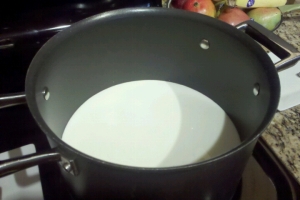
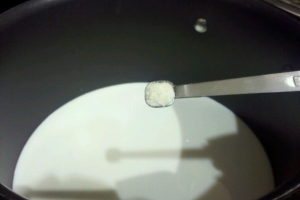
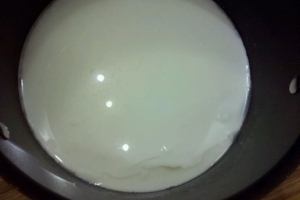

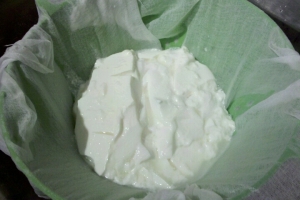

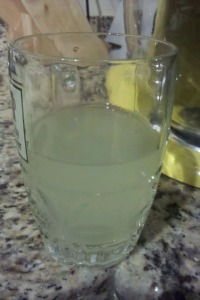
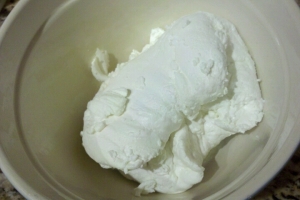
One Reply to “Chèvre Recipe”